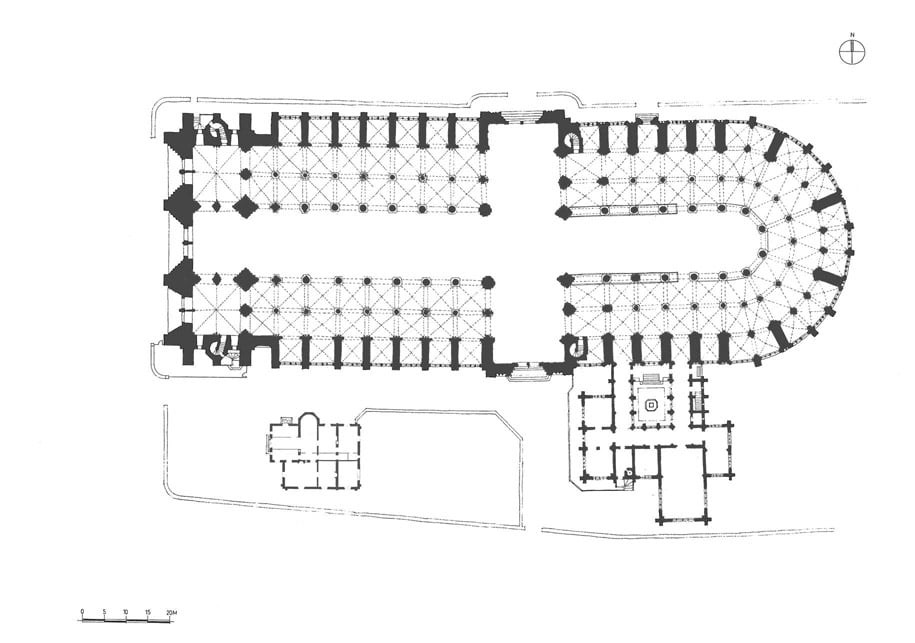Notre Dame Cathedral, a name synonymous with Parisian grandeur and Gothic architectural brilliance, stands as a beacon of history and faith in the heart of France. Before the devastating fire of 2019, this iconic monument welcomed over 12 million visitors annually, solidifying its place as one of the world’s most cherished landmarks and a designated UNESCO World Heritage site as part of the Paris Banks of the Seine. But for those planning a visit, either physically or virtually, the first question often is: Where Is Notre Dame Cathedral located?
This article will delve into the precise location of Notre Dame, explore its historical context on the Île de la Cité, and provide key details for anyone seeking to understand or visit this magnificent cathedral.
Locating Notre Dame Cathedral: Address and Key Details
Notre Dame Cathedral is strategically positioned in the very center of Paris, on an island that is considered the historical birthplace of the city. Knowing the exact address and its surrounding context is crucial for understanding its significance.
Precise Address and Arrondissement
The official Notre Dame de Paris address is:
6 Parvis Notre-Dame – Pl. Jean-Paul II, 75004 Paris, France
Breaking down this address reveals important details:
- 6 Parvis Notre-Dame – Pl. Jean-Paul II: This indicates the cathedral’s location on the parvis, an enclosed public square directly in front of Notre Dame. The square is also named in honor of Pope John Paul II.
- 75004 Paris: This is the postal code for the 4th arrondissement of Paris. The arrondissement is an administrative district of Paris, and Notre Dame is situated in the 4th arrondissement. This district is on the Right Bank of the Seine and is known as Le Marais, a historically rich and vibrant area of Paris.
Understanding the arrondissement places Notre Dame within a specific cultural and geographical context within Paris.
Île de la Cité: The Historical Island Setting
Perhaps the most crucial geographical detail in answering “where is Notre Dame Cathedral” is its location on the Île de la Cité. This translates to “Island of the City” and is one of two remaining natural islands in the Seine River within Paris (the other being Île Saint-Louis).
 Notre Dame Cathedral Paris
Notre Dame Cathedral Paris
Alt text: Interior view of the nave of Notre Dame Cathedral in Paris, showcasing its Gothic architecture.
Île de la Cité is not just any island; it is considered the historical heart of Paris. It was settled in pre-Roman times and was known as Lutetia during the Roman era. Historians believe that Notre Dame de Paris was intentionally built on this island, on the ruins of even earlier religious structures. These included a Roman temple dedicated to Jupiter and a subsequent early Christian Romanesque basilica. This layering of sacred sites underscores the enduring spiritual significance of this location.
By placing Notre Dame on Île de la Cité, the builders chose a location that was not only geographically central but also symbolically resonant with centuries of Parisian history and spiritual heritage.
A Cathedral Steeped in History
Knowing where Notre Dame is located is intertwined with understanding when and why it was built there. Its history is a key part of its identity.
Construction Timeline and Architectural Evolution
Construction of Notre Dame began in 1163, under the reign of King Louis VII, and continued for nearly two centuries, with major completion around 1345. However, like many grand cathedrals, modifications and additions were made over the subsequent centuries, reflecting evolving architectural styles and needs.
This lengthy construction period is significant because it spans the transition from Romanesque to Gothic architecture. Notre Dame is considered a prime example of French Gothic architecture, showcasing innovative techniques and aesthetic ideals of the period.
From Roman Temple to Gothic Masterpiece
The choice to build Notre Dame on the Île de la Cité was deliberate and historically layered. As mentioned, the site was previously home to Roman and early Christian religious buildings. This continuity highlights the cathedral’s role as a successor to earlier forms of worship and a powerful statement of Christian dominance in medieval Paris.
The location was not just about religious succession; it was also about civic prominence. Île de la Cité was the center of royal power in the 12th century, and placing the cathedral there cemented its importance in both the spiritual and secular life of the city.
Visiting Notre Dame Today: What’s Open and What to Expect
For those planning a visit to see where Notre Dame Cathedral is in person, it’s important to understand the current situation following the 2019 fire.
Current Closure and Reopening Timeline
Tragically, on April 15, 2019, a devastating fire caused significant damage to Notre Dame’s roof and spire. As a result, the cathedral remains closed to the public for interior visits until further notice.
However, there is a hopeful timeline. The French government, under President Emmanuel Macron, has set a goal to reopen Notre Dame to the public by 2024. Restoration and reconstruction efforts are ongoing, and this date remains the target for a partial reopening, though full restoration will likely take longer.
Exploring the Parvis and Virtual Tours
While interior visits are not possible, the “parvis” of Notre Dame has been accessible to the public since May 2020. This enclosed square in front of the cathedral offers excellent exterior views of the facade and allows visitors to appreciate the scale and grandeur of the building from the outside.
 Friends of Notre-Dame de Paris is the official 501(c)(3) charity leading the international fundraising efforts to rebuild and restore Notre-Dame Cathedral.
Friends of Notre-Dame de Paris is the official 501(c)(3) charity leading the international fundraising efforts to rebuild and restore Notre-Dame Cathedral.
Alt text: Exterior view of Notre Dame Cathedral in Paris, highlighting its iconic facade and Gothic architecture.
For those unable to visit Paris in person, or wanting a glimpse inside during the closure, virtual tours of Notre Dame are available online. These tours offer a way to explore the interior virtually and learn more about its art and architecture even while restoration is underway.
Notre Dame’s Architectural Significance
Beyond its location and history, Notre Dame’s architectural brilliance is a major reason why people want to know where Notre Dame Cathedral is. It is a masterpiece of design and engineering.
Gothic Masterpiece: Key Architectural Features
Notre Dame is celebrated as a prime example of Gothic architecture. Key features that define this style and are prominently displayed in Notre Dame include:
- Pointed Arches: These are used throughout the structure, distributing weight more efficiently than rounded Romanesque arches, allowing for taller and more open spaces.
- Ribbed Vaults: The ceilings are constructed with ribbed vaults, creating a sense of height and lightness.
- Flying Buttresses: Perhaps the most visually striking Gothic innovation, flying buttresses are external supports that redistribute the weight of the roof and walls, allowing for thinner walls and larger windows.
Rose Windows, Flying Buttresses, Portals
Notre Dame is particularly famous for specific architectural elements:
- Rose Windows: The cathedral features three magnificent rose windows, large circular stained-glass windows. Notably, only one retains its original 13th-century glass, but all are stunning examples of Gothic stained glass artistry.
 notre dame sol
notre dame sol
Alt text: A close-up view of the intricate stonework and design details at the base of Notre Dame Cathedral in Paris.
- Flying Buttresses: As mentioned, these are essential structural and aesthetic elements, contributing to the cathedral’s soaring verticality and iconic silhouette.
- Portals: The western facade features three elaborately sculpted portals: the Portal of the Virgin, the Portal of the Last Judgment, and the Portal of Saint Anne. Each is adorned with intricate sculptures depicting biblical scenes and figures, showcasing the artistic skill of medieval artisans.
Notre Dame and the 2019 Fire: Restoration and Rebirth
The question “where is Notre Dame Cathedral” also carries a sense of urgency and concern in the wake of the 2019 fire. The ongoing restoration is a testament to the cathedral’s enduring importance.
The Fire and Its Aftermath
The fire of April 2019 was a global tragedy, causing widespread damage to Notre Dame. The spire collapsed, the roof was largely destroyed, and significant damage occurred to the interior. However, thanks to the efforts of firefighters, the main structure, including the iconic facade, towers, and much of the interior stonework, was saved.
Ongoing Restoration Efforts and Future Outlook
Immediately following the fire, a massive international fundraising effort began to support the rebuilding and restoration of Notre Dame Cathedral. Expert artisans and historians are working meticulously to restore the cathedral to its former glory, using traditional techniques and materials wherever possible.
The commitment to rebuild Notre Dame underscores its significance not just as a religious building or a historical monument, but as a symbol of French resilience and cultural heritage. While the restoration is a complex and lengthy process, the determination to bring Notre Dame back to its full splendor is unwavering.
Conclusion
Where is Notre Dame Cathedral? It is located at the geographical and historical heart of Paris, on the Île de la Cité, in the 4th arrondissement. Its precise address is 6 Parvis Notre-Dame – Pl. Jean-Paul II, 75004 Paris, France.
More than just an address, Notre Dame’s location is integral to its identity. Situated on the ancient Île de la Cité, it stands as a testament to centuries of Parisian history, architectural innovation, and spiritual significance. While currently undergoing restoration, Notre Dame Cathedral remains a powerful symbol and a must-know location for anyone interested in Paris, history, or architectural marvels. As the restoration progresses towards the anticipated 2024 reopening, the world eagerly awaits the resurgence of this iconic landmark in the heart of Paris.

